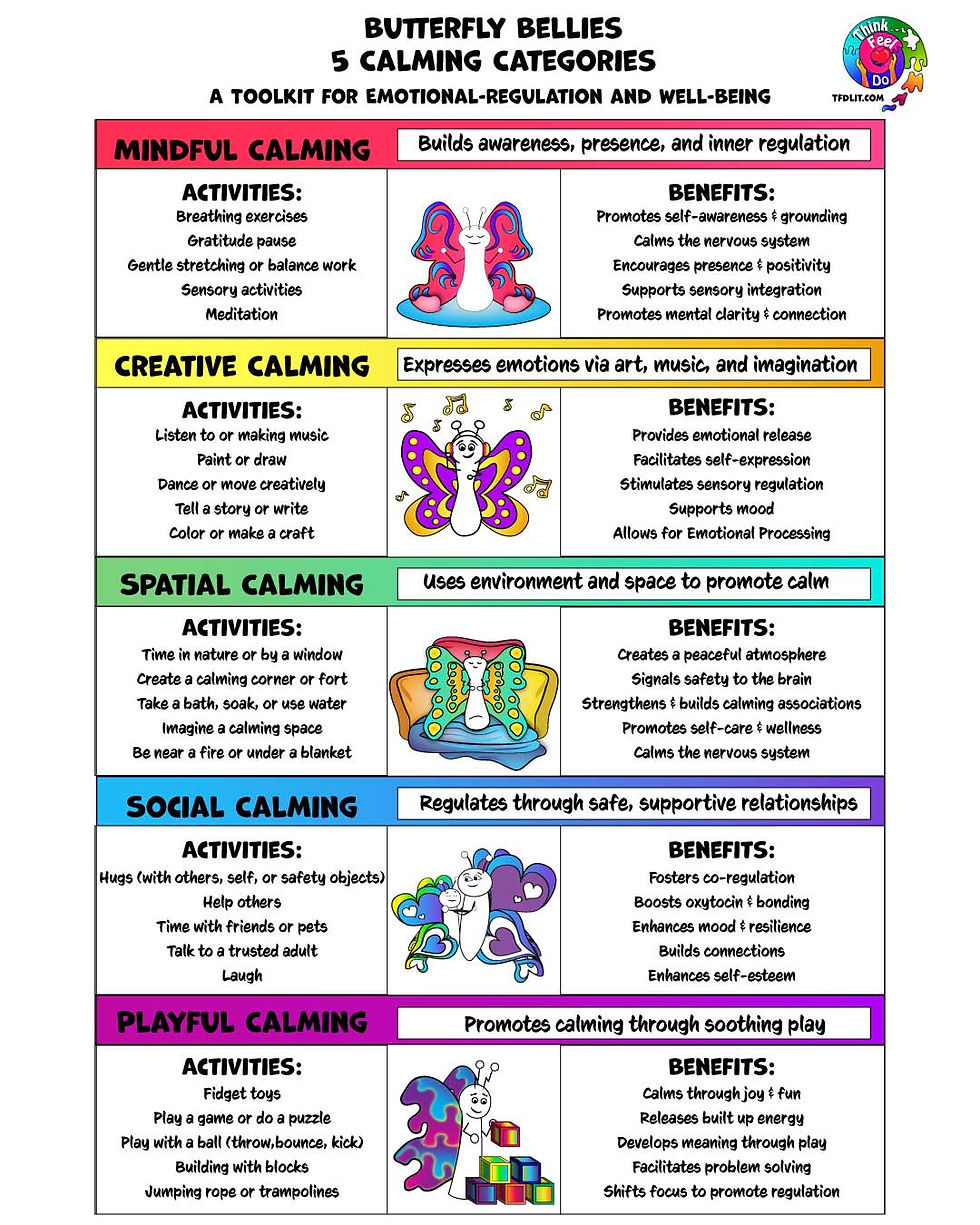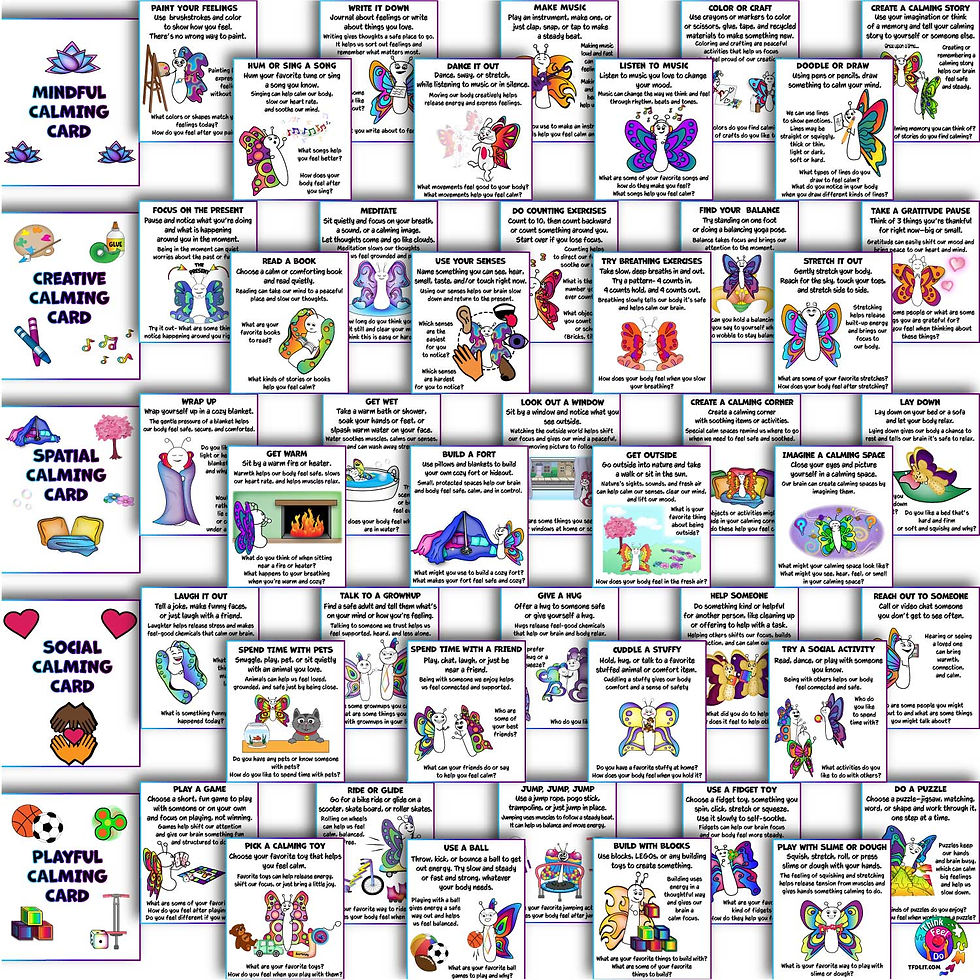Five Paths to Calm: Personalized Strategies for Kids and Grown-Ups
- Christy Holt, LMHC

- May 9
- 6 min read
In today’s fast-paced world, calming down isn’t always as simple as taking a deep breath. While some of us recharge with quiet time, others need movement, connection, or creativity to feel regulated. That’s why understanding the different types of calming activities can be so helpful—not just for kids, but for all of us.
Here are five calming categories to help you or your child reset in ways that are personalized, meaningful, and sustainable: playful, spatial, creative, mindful, and social.

Mindful Calming
Mindful calming strategies offer powerful benefits by helping to build awareness, presence, and emotional regulation from the inside out. This category brings us inward, inviting stillness, reflection, and intentional focus. Mindful calming shifts attention away from chaos and helps us connect with our breath, body, and the present moment.
Some examples of mindful calming include:
Breathing exercises – There are many types of breathing practices, each offering proven benefits such as reducing stress, improving concentration, lowering heart rate, and creating a sense of inner calm. Techniques like box breathing, belly breathing, 4-7-8 breathing, or simply slowing the breath can activate the body’s relaxation response and help us return to a regulated state.
Gratitude pauses – Practicing gratitude has far-reaching effects and can instantly shift our mood and mindset. Taking a moment to reflect on what we’re thankful for—even something small—can reframe negative thought patterns, foster emotional resilience, and build a habit of noticing the good. Writing in a gratitude journal or simply saying what you're thankful for out loud can boost calm and connection.
Stretching – Gentle stretching connects us to our body and breath. Slow, mindful movement allows us to release tension stored in muscles and encourages physical and mental flexibility. When paired with intentional breathing, stretching can regulate energy levels, calm the nervous system, and improve self-awareness and emotional balance.
Mindful calming has powerful benefits, including:
Improving overall self-regulation through breathing, meditation, and mindfulness
Enhancing physical awareness through practices like balance, stretching, and grounding
Promoting clarity, calm, and connection by focusing on the present moment
Supporting a positive mindset through gratitude, self-reflection, and sensory awareness
Creative Calming
Creative calming allows emotions to be expressed through art, music, writing, or imaginative exploration. It’s not about the final product—it’s about the process of creating and expressing. This type of calming offers a healthy outlet for strong emotions and a way to process big feelings, even when they’re difficult to put into words.
Some examples of creative calming include:
Listening to or making music – Music is a powerful calming strategy that can shift your emotional state in just moments. Listening to soothing music can slow the heart rate, regulate breathing, and create a sense of emotional safety. Playing an instrument, singing, or making beats with your body allows for active self-expression and helps the brain and body sync into a more regulated rhythm. Whether it's calming melodies, steady beats, or expressive lyrics, music helps externalize emotions in a healthy and meaningful way.
Painting or Drawing – The painting and drawing process offers a soothing sensory experience. Blending colors, making brushstrokes, or sketching lines provides both visual and tactile feedback that can help calm the nervous system. These forms of art let us represent feelings visually—without needing words—and can offer a sense of release, control, and creativity, whether through bold lines or soft shades.
Dancing or moving creatively – Movement can be a natural release for tension stored in the body. Creative movement, especially when paired with music, allows for emotional expression without judgment. Children and adults alike can benefit from dancing freely, swaying, stretching, or inventing movements that mirror how they feel inside. Movement helps regulate energy, reduce stress hormones, and reconnect the mind with the body in a calming, intuitive way.
Creative calming also engages the senses, making it a powerful tool for emotional regulation. Here are a few ways it appeals to different sensory systems:
Visual – Painting, drawing, or exploring visual art and color
Tactile – Working with clay or 3D materials, finger painting, or writing by hand
Physical – Dancing, yoga, or creative movement activities
Auditory – Listening to music, making rhythms, or experimenting with sound
Taste – Cooking, baking, and trying new or artistic recipes
Scent – Making candles, mixing essential oils, or exploring calming smells creatively
Spatial Calming
Spatial calming is about how we use our environment and physical space to create a sense of safety, comfort, and regulation. The spaces around us can have a powerful effect on the nervous system. When used intentionally, space can cue the brain to slow down, release tension, and return to a calmer state. By building calming associations with certain environments, we can help the body feel grounded and the mind feel at ease.
Some spatial calming strategies include:
Going Outside – Spending time in nature can significantly soothe the mind and body. Stepping onto the earth provides a grounding experience. Weather itself can offer calming sensations—from the warmth of the sun to the gentle rhythm of falling rain. Natural sights, sounds, smells, and textures—like birdsong, fresh-cut grass, or a cool breeze—can activate the senses and promote relaxation.
Creating a Calming Corner – Children (and adults!) benefit from having a dedicated space to decompress and recharge. The process of selecting meaningful items for a calming corner—such as soft textures, comforting visuals, or favorite fidgets—can be empowering. Returning to the same space to practice self-soothing supports strong self-regulation skills over time.
Using Water for Calm – Water can be incredibly regulating for the body. This might look like a bath, shower, hot tub, or even soaking your feet or splashing cool water on your face. Many people find the feeling of warm water calming and peaceful. Adding bubbles, soothing scents, or dim lighting can enhance the calming effect.
Calming spaces are powerful tools because they:
Help us create a personalized calming atmosphere, such as building a fort or imagining a safe space in the mind
Cultivate feelings of safety and comfort—like curling up in bed, wrapping in a blanket, or sitting in a favorite chair
Strengthen and build calming associations—such as sitting by a cozy fire or heater, going outside, or simply gazing out a window
Promotes self-care- many calming spaces allow for opportunities for self-care, such as taking a bath or taking time for oneself.
Social Calming
Some people regulate best in the presence of others. Social calming doesn’t always require conversation—it’s about feeling safe, connected, and seen. This type of calming can be especially powerful for children with strong attachment needs or for adults who feel soothed through relationships. Social calming often involves co-regulation—the process where one person helps another manage their emotions by modeling calmness, offering support, and creating a sense of shared safety. This is especially important for young children who are still developing their ability to self-regulate.
Examples of social calming include:
Giving a Hug – Whether it’s a hug from a loved one or a self-hug, the power of physical touch is deeply calming. Hugs can reduce stress, release oxytocin (the "bonding hormone"), and help regulate emotions like fear and anxiety. Even brief moments of affectionate contact can boost mood and ease the nervous system.
Helping Someone – Acts of kindness help shift attention away from overwhelming emotions and toward meaningful action. Helping others promotes connection, improves self-esteem, and stimulates the release of calming chemicals like dopamine and oxytocin.
Spending Time with a Friend – Being around trusted people offers emotional support, opportunities for laughter, and shared experiences that reduce stress. Social time with friends builds connection, relieves loneliness, and increases resilience and self-regulation.
Other benefits of social calming include:
Building connection and a sense of belonging—like spending time with loved ones or participating in group activities
Promoting emotional safety—such as talking with a trusted adult or cuddling a comfort object or stuffed animal
Increasing joy and confidence—through interactions with pets, helping others, or simply being with people who bring comfort
Playful Calming
Sometimes, the best way to wind down is to lighten up. Playful calming includes activities that bring joy, laughter, and spontaneity. While it might not look “calm” from the outside, play helps discharge stress and brings the nervous system back into balance.
Some playful calming strategies include:
Doing a puzzle- jigsaw puzzles, word, number or shape puzzles, matching puzzles and mazes all offer a great way to slow down our brain and focus our thoughts and energy. To facilitate calming, best to stick with simple, age-appropriate puzzles. Puzzles that are too hard can lead to increased stress or frustration.
Playing with a ball- throw, catch, or kick a ball to release energy, shift focus, restore balance, and have fun. Dribbling a basketball, once you get your rhythm, can be an excellent calming technique because you can feel, hear, and see the steady beat of the ball, which is known to be soothing for young and old.
Fidget toys- Fidget toys offer many different ways to relieve restless energy through different types of repetitive motion such as squeezing, flipping, spinning, popping, and clicking. Fidget toys can provide a powerful calming outlet, enhance focus and attention, and promote emotional-regulation and self-soothing.
Play is a powerful tool that can:
Release of built-up energy, like jumping on a trampoline or pogo stick or riding a bike;
Provide a helpful distraction and shift our focus, like playing a game or building with blocks;
Cultivate calming energy and soothe big feelings, like playing with slime or sensory bins or cuddling a stuffed animal; and
Help work through emotions and practice problem solving by playing out challenging situations with dolls or action figures.
For more on these calming categories, check out the new Calming Category Card Deck available on TPT Calming Category Card Deck- 45 Illustrated Cards for Emotional Regulation




Comments